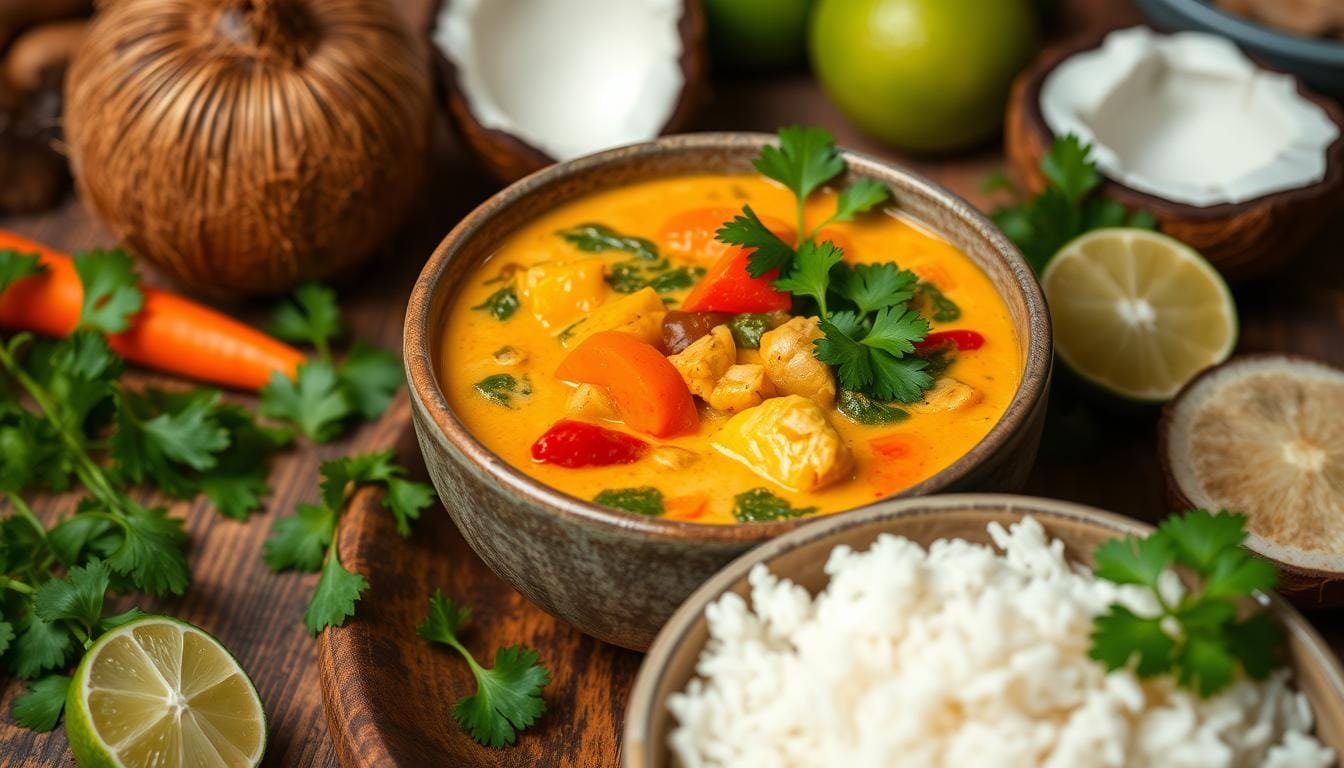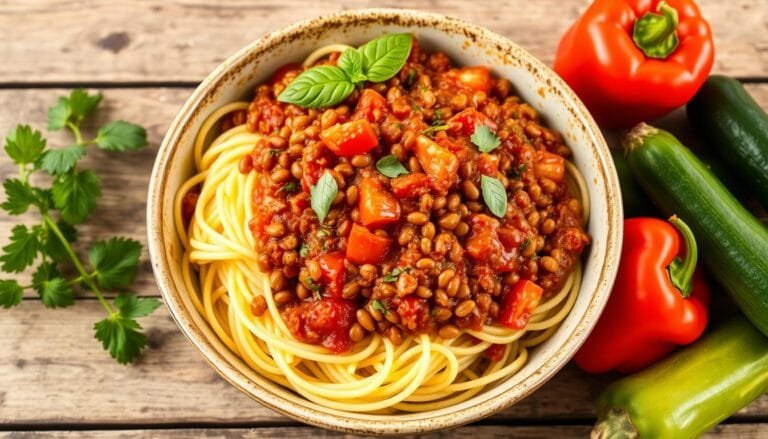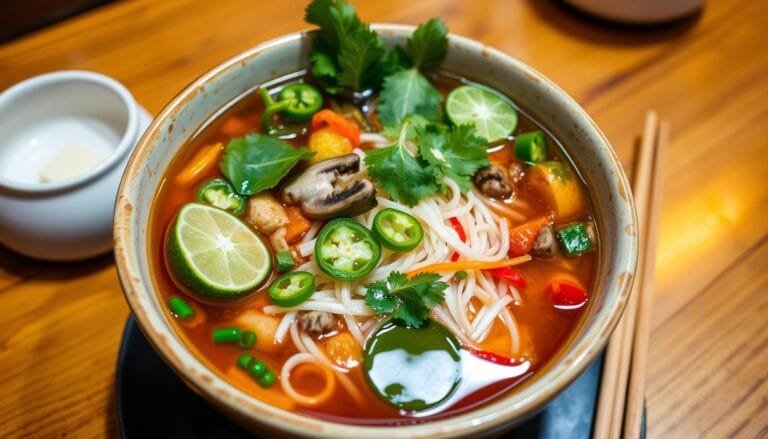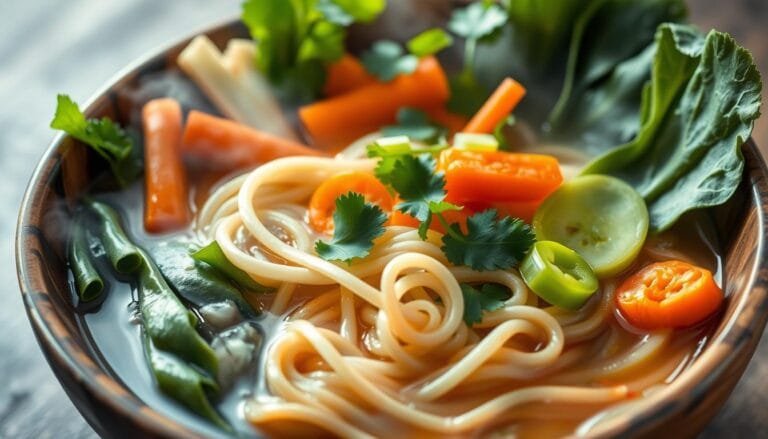As a busy home cook, I’m always searching for quick, healthy meals. This easy plant-based coconut curry recipe is perfect. It’s creamy, aromatic, and ready in under 30 minutes with simple ingredients.
This coconut curry lets you enjoy takeout flavors at home, without the bad stuff. You can pick your favorite veggies and spices. It’s great for a vegan dinner or just a healthy meal you’ll love.
Why This Coconut Curry Will Become Your New Favorite Dish
Get ready to indulge in a delicious and nutritious curry that will change your weeknight dinners. This plant-based coconut curry is a treat for your taste buds. It also comes with impressive health benefits that will make you want more.
Health Benefits of Plant-Based Curry
The colorful vegetables in this curry are packed with vitamins, minerals, and antioxidants. The anti-inflammatory spices, like turmeric and ginger, make it a strong supporter of your health. Plus, the fiber will keep you full and energized for hours.
Perfect for Busy Weeknight Dinners
This time-saving recipe is a lifesaver for busy weeknights. It only takes 15 minutes to prep and 50 minutes to cook. You’ll have a tasty, healthy dinner ready in no time. You can also try different vegetables or use frozen ones for extra convenience.
Get ready to enjoy the best of flavorful, plant-based cooking with this coconut curry recipe. It’s destined to become a favorite in your home, satisfying your taste buds and nourishing your body. Dive in and discover the magic of this versatile and time-saving recipe!
Essential Ingredients for the Perfect Plant-based Coconut Curry Recipe
Making a tasty vegan coconut curry needs the right ingredients. At its core is full-fat coconut milk, which makes the curry rich and creamy. A mix of spices, like curry powder or curry paste, adds warmth and flavor.
Adding a variety of veggies like sweet potatoes, bell peppers, and kale makes the dish colorful and nutritious. These veggies bring important vitamins, minerals, and fiber.
Onions and garlic add depth to the curry’s taste. A bit of tamari or soy sauce and maple syrup balance the flavors, making it sweet, savory, and umami.
For more protein, you can add vegan sausage or chickpeas. Shredded coconut adds a nice texture and extra indulgence.
| Ingredient | Quantity |
|---|---|
| Full-fat coconut milk | 1 (13.5 oz) can |
| Curry powder or curry paste | 2-3 tbsp |
| Sweet potatoes, diced | 2 cups |
| Bell peppers, sliced | 1 cup |
| Kale, chopped | 2 cups |
| Yellow onion, diced | 1 medium |
| Garlic, minced | 3 cloves |
| Tamari or soy sauce | 2 tbsp |
| Maple syrup | 1 tbsp |
| Vegan sausage, sliced (optional) | 1 cup |
| Shredded coconut (optional) | 1/4 cup |
With these ingredients, you can make a delicious and healthy vegan coconut curry. It’s sure to be a hit with your family.
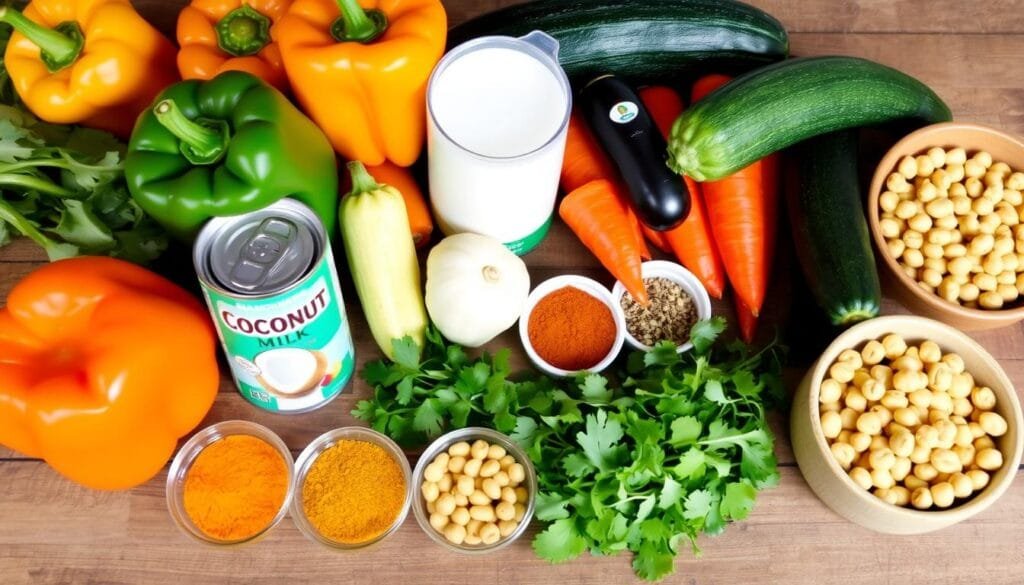
The Magic of Full-Fat Coconut Milk in Curry
Full-fat canned coconut milk is the key to a creamy, indulgent curry base. It offers a rich, velvety texture. This makes it perfect for building layers of flavor in your plant-based curry.
Types of Coconut Milk to Use
While light coconut milk can work, full-fat canned coconut milk is better. It has a higher fat content, making the curry richer and creamier. You can also use fresh coconut milk from young Thai coconuts for a more authentic taste.
How to Select the Best Coconut Milk
When buying canned coconut milk, choose BPA-free options. Avoid brands with additives or stabilizers. Opt for ones with fewer ingredients. One 14 oz can of high-quality coconut milk is like 1 3/4 cups of fresh homemade coconut milk.
| Ingredient | Quantity |
|---|---|
| Prep time for the coconut curry sauce | 5 minutes |
| Total time to make the coconut curry sauce | 5 minutes |
| Servings | 8 |
| Recommended range of curry paste | 1-2 tablespoons |
| Calories per serving | 115kcal |
| Percentage of daily value for fat | 18% |
| Percentage of daily value for saturated fat | 50% |
| Percentage of daily value for potassium | 4% |
| Percentage of daily value for fiber | 4% |
| Percentage of daily value for iron | 6% |
Coconut milk is the base of the Vegan Magic Curry Sauce. It needs 270 ml, whether it’s full cream or light.
Choosing the Right Vegetables for Your Curry
Choosing the right vegetables is key to a great plant-based coconut curry. The right mix can make the dish taste better and be healthier. I always pick a variety of colorful, seasonal veggies for a balanced and tasty meal.
My favorite curry vegetables are sweet potatoes, bell peppers, kale, cauliflower, and frozen mixed veggies. Sweet potatoes add a sweet taste that goes well with coconut milk. Bell peppers and kale add crunch and vitamins. Cauliflower and frozen mixed veggies soak up the curry sauce nicely.
Adding apples can also be a good idea. Their sweetness can match the savory curry flavors. When picking your seasonal produce, choose a mix of vegetable combinations for different textures, colors, and tastes.
| Vegetable | Benefit |
|---|---|
| Sweet Potatoes | Natural sweetness, rich in vitamins A and C |
| Bell Peppers | Crunchy texture, high in vitamin C |
| Kale | Leafy greens, packed with vitamins and minerals |
| Cauliflower | Absorbs flavors well, provides fiber and nutrients |
| Apples | Adds a unique sweetness to the curry |
By carefully choosing a mix of curry vegetables, seasonal produce, and vegetable combinations, you can make a delicious and healthy plant-based coconut curry. It will surely please your taste buds.

Mastering the Curry Spice Blend
Making a tasty plant-based coconut curry starts with the spice blend. While curry powder is easy to use, making your own curry paste can elevate the taste. It’s all about knowing the different curry powder varieties and finding the right mix for a perfect homemade curry blend.
Understanding Different Curry Powders
Curry powders vary a lot in what they’re made of and their spice levels. Turmeric adds warmth, while cayenne gives a strong kick. Trying out different mixes, like garam masala or Madras curry powder, can add special touches to your curry.
Creating Balanced Flavors
- Begin with ginger, garlic, and onions for a strong base.
- Add spices like cumin, coriander, and cardamom for depth.
- Change the spice levels by adjusting cayenne or red chili powder.
- Try spices like fenugreek, fennel, or cinnamon for a richer taste.
Knowing how to mix different curry powder varieties and making a balanced homemade curry blend will make your coconut curry amazing. It promises a delicious and fulfilling meal.
Step-by-Step Cooking Instructions
Making a tasty plant-based coconut curry is easy and quick. The secret to this easy curry recipe is the curry cooking method. It lets you make a flavorful, one-pot meal in minutes.
- Begin by sautéing the aromatic ingredients. In a big pot or Dutch oven, heat some olive oil over medium heat. Add diced onions, minced garlic, and grated ginger. Cook until the onions are clear, about 5 minutes.
- Then, mix in the spices. Add your favorite curry powder, and other spices like cumin, chili powder, or turmeric. Cook for 1-2 minutes, letting the spices toast and smell great.
- Now, add the coconut milk. Slowly pour in the full-fat coconut milk, stirring well to avoid separation. Let it gently boil.
- Next, add the vegetables. Put in your favorite veggies, like diced potatoes, carrots, cauliflower, or broccoli. For quicker cooking, pre-cook the potatoes or microwave them a bit before adding them to the curry.
- Let it simmer until tender. Lower the heat to low and simmer, stirring now and then, until the veggies are soft, about 15-20 minutes.
- Finish with final seasonings. Add any extra seasonings, like salt, pepper, or a squeeze of lime juice, to taste.
By following these easy steps, you can make a delicious, creamy curry dish. It’s perfect for a quick and satisfying dinner any night of the week.
Tips for Achieving the Perfect Curry Consistency
Making the perfect curry is about finding the right balance of flavors and texture. You might like your curry thick and creamy or light and smooth. Here are some tips to help you get it just right every time.
Troubleshooting Common Issues
If your curry is too thin, it’s easy to fix. Just let it simmer uncovered to let some liquid evaporate. This will make your curry thickness better. On the other hand, if it’s too thick, add a little water or vegetable stock. This will make it creamier and more fluid.
Be careful not to boil the coconut milk. Boiling can make it separate and look curdled. Instead, simmer the curry gently to keep the curry flavor rich and smooth.
Making Adjustments to Taste
While your curry is simmering, taste it and adjust the seasonings as needed. Remember, adding vegetables will dilute the flavor. So, you might need to add more salt, spice, or sweetness to balance it.
- For a stronger curry flavor, add more curry powder or a pinch of cayenne pepper.
- If it’s too spicy, a dollop of yogurt or a squeeze of lemon can help cool it down.
- To make it creamier, stir in a bit of coconut milk or heavy cream.
Getting the perfect curry consistency takes practice, but with these tips, you’ll soon be making restaurant-quality curries. Enjoy the flavorful journey!
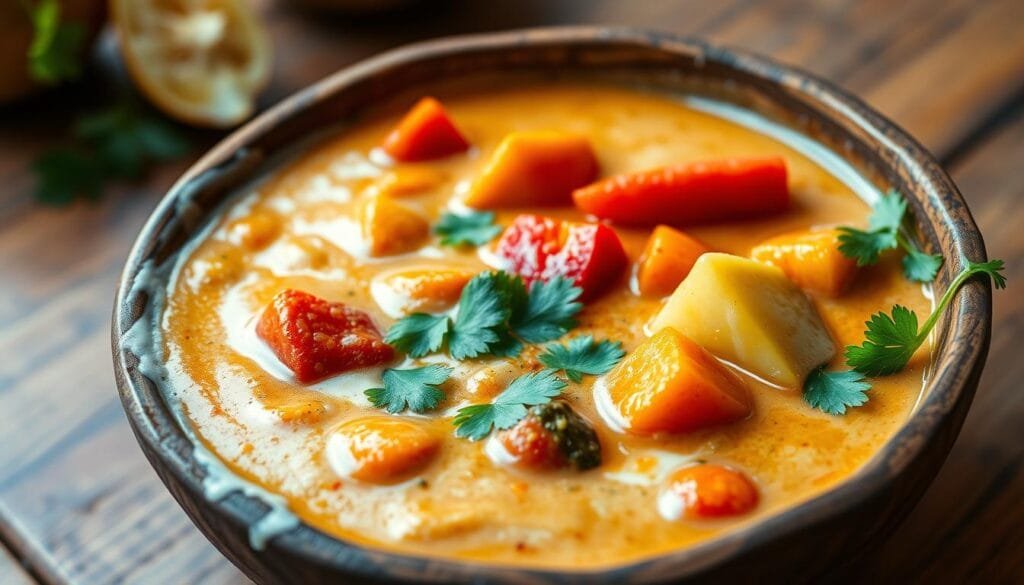
Serving Suggestions and Pairings
This delectable plant-based coconut curry is versatile. It pairs well with many accompaniments. This makes it a dish you can enjoy in different ways.
Try it over basmati rice or brown rice for a classic taste. For a gluten-free option, cauliflower rice or quinoa work great. You can even serve it over carrot rice or rice noodles for a fun twist.
No curry feast is complete without naan bread or other Indian flatbreads. They’re perfect for scooping up the curry sauce.
| Curry Accompaniments | Rice Pairings | Serving Ideas |
|---|---|---|
| Naan bread | Basmati rice | Curry soup (warm or chilled) |
| Indian flatbreads | Brown rice | Over rice noodles |
| – | Quinoa | With cauliflower rice |
| – | Carrot rice | – |
For a heartier meal, enjoy the curry as a soup. You can serve it warm or chilled. It’s comforting and satisfying, perfect for a cool day.
There are endless ways to serve and pair this delicious curry. Try different grains, breads, and styles to find your favorite.
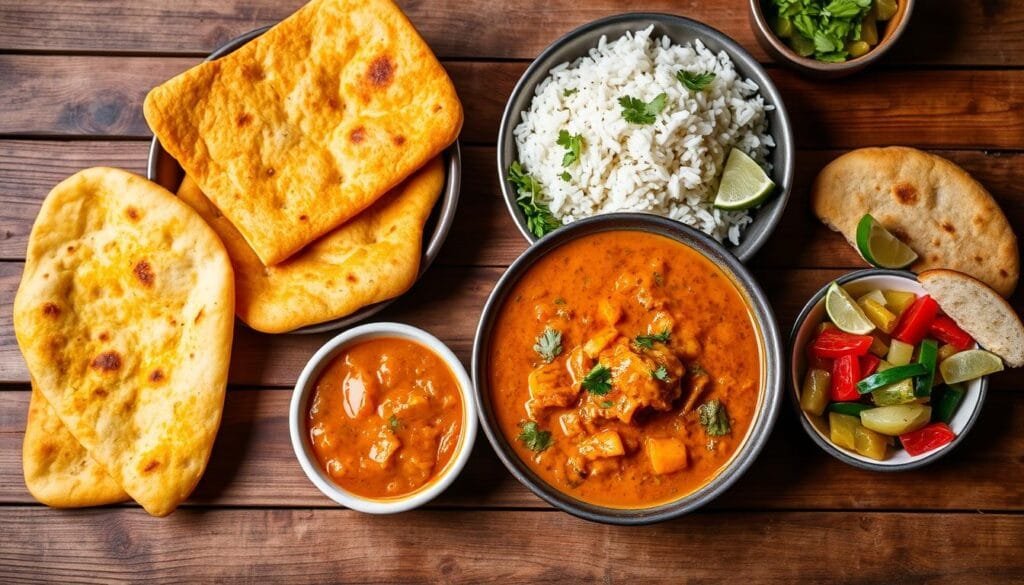
Storage Tips and Meal Prep Options
This tasty plant-based curry leftovers is easy to store and prep for meals. Follow a few simple tips to enjoy this coconut curry all week.
First, storing the curry leftovers is straightforward. The recipe yields about 4 servings. Any leftovers can be stored in an airtight container in the fridge for 3-4 days. Reheat them on the stovetop or in the microwave when you’re ready.
For longer storage, you can freeze the curry for up to 3 months. Portion it out into individual servings or freezer-safe containers before freezing. The coconut milk’s texture might change when thawed, but the flavor remains great.
When it comes to meal planning, this curry is ideal for batch cooking and prep. Cook a big batch over the weekend. Then, portion it out for easy lunches or dinners during the week. Serve it over rice, quinoa, or with roasted veggies for a full meal.
This curry recipe is also super flexible. Try different veggies, adjust the spice, or add tofu or plant-based “chicken” bits. The options are endless!
Looking to save time on busy nights or enjoy this curry all week? These tips have you covered. Enjoy your delicious meals!
Variations and Customization Ideas
This plant-based coconut curry recipe is very versatile. You can change it to fit your taste or use seasonal produce. Let’s look at some fun ways to make this dish your own.
Seasonal Vegetable Substitutions
You can swap out different veggies based on what’s in season. Try using butternut squash or pumpkin instead of sweet potato. Carrots, parsnips, and beets are great together too.
In summer, add zucchini, bell peppers, and eggplant. Fall is perfect for kale, Brussels sprouts, or cauliflower.
Adjusting Spice Levels
Want more heat? Increase the curry powder or add a minced jalapeño. A pinch of crushed red pepper flakes can also add a kick. For a milder taste, use less curry powder or skip the chili peppers.
Customizing this coconut curry is all about having fun. Try different veggies, proteins, and spices to create your own dish. The goal is to enjoy the process and find the perfect flavor for you.
Time-Saving Tips for Quick Curry Preparation
As a busy home cook, I’m always looking for ways to make meal prep faster without losing flavor. Making a delicious plant-based coconut curry is easier with a few tricks. These tips help save time and make the process more efficient.
First, I use pre-cut or frozen vegetables to save time. Not chopping onions, peppers, and other veggies is a big time-saver. Just toss them in the pan and you’re halfway there! Also, microwaving potatoes before adding them to the curry can cut down cooking time.
Preparing larger batches of curry is another time-saver. It’s great for leftovers and freezing portions for quick meals later. I also keep my pantry stocked with curry essentials like spices, coconut milk, and tomato paste. This way, I’m ready when time is tight.
